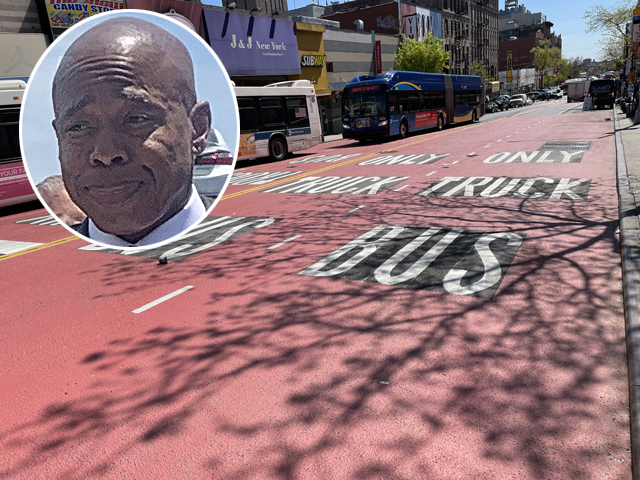Mayor Adams said he listened to the "community" when he decided to reduce the hours of two busway pilots that he made permanent earlier this year — but the community he's citing clearly aren't the bus riders whose lives he promised to improve just two months ago.
Back in June, Hizzoner, together with the MTA, vowed to improve the city's beleaguered transit system by building out 150 miles of new bus lanes and busways over the next four years, including 20 by end of this year. But on Monday, even before he'd hit even five new miles of proposed bus lanes this year, the mayor justified his plans to cut the hours that the 181st Street car-free stretch in Washington Heights and Inwood from 6 a.m. to 10 p.m., to 6 a.m. to 8 p.m. as one his “trademark” traits: listening to the community.
Adams claimed he was listening to local voices when he pulled a similar maneuver on the successful Main Street busway in Flushing, reducing its hours of operation from all day to 6 a.m. to 7 p.m. — effectively creating 13 fewer hours of busway for the congested neighborhood.
“There's one thing that's my trademark. I am going to always listen to communities. That's what I'm going to do,” Adams said during an unrelated press conference on Monday, when asked by reporter Kevin Duggan how he reconciles New York's (and his own) reputation as a 24-hour entity when Adams's busways stop running before dark. (Duggan first reported Adams's 181st Busway truncation on Sunday in amNY.)
“Community leaders communicated with us," he said. "We heard them. We're not going to be deaf to the voices of the people who actually live in the community and they use those buses.”
When I asked the Mayor why busways he made permanent in Flushing and Washington Heights had scaled back hours, Adams said he and DOT listened to the community and riders pic.twitter.com/14l4HX4z8J
— Kevin Duggan (@kduggan16) August 1, 2022
Adams didn't name any specific "community leaders" upon which he's basing his decision, but it's clear from a June 23 Department of Transportation presentation regarding the new hours that he didn't mean riders, but rather business owners, who have claimed confusion over regulations, loss of parking, and not enough loading zones.
Actual bus riders, on the other hand, according to a DOT survey, said that since the 181st Street busway went into effect, service has felt “more frequent” and “faster,” and the thoroughfare safer to cross. If Adams had actually listened to riders as part of the "community," then he would not have sacrificed workers' time who traverse 181st Street to and from the Bronx and their jobs in Washington Heights, according to Danny Pearlstein of Riders Alliance.
“Evening commuters aren't in any less of a hurry than riders working nine to five — in fact it's the opposite," he said. "And 181st Street is a direct line from the Bronx to major employment centers in Washington Heights, including New York Presbyterian Hospital. Which Bronxites were consulted before the busway was watered down?”
FWIW, 'communities' exactly the excuse @BilldeBlasio used whenever he felt like not doing more for bus riders.
— Danny Pearlstein (@dannypearlstein) August 1, 2022
The 'community' of a busway must include everyone who rides the bus there. 181st Street is a critical bus corridor for Bronxites who work in Manhattan. https://t.co/paLoMEzFLA
The 181st Street busway got off to a rocky start. It was first promised by ex-Mayor de Blasio way back in 2020 as a way to speed up commute times for struggling straphangers, who have had to suffer through abysmal 3.7 miles per hour speeds for too long.
Yet the red paint wasn’t rolled out until April, 2021. And according to DOT, the bus speeds almost immediately improved — up to 32 percent during morning and evening rush hour.
Nonetheless, despite benefiting riders, it was cut by two hours. And advocates were still fuming over the Main Street cuts.
“Under political pressure, (DOT) was forced to limit the hours of the (Main Street busway) — regardless of consequences to transit reliability and street safety. Traffic fatalities as a result of this decision will be noted,” said John Choe, the executive director of the Greater Flushing Chamber of Commerce.
One caveat to today's good news: under political pressure, @NYC_DOT was forced to limit the hours of #MainStreetBusway (from 24/7) to 6am to 7pm -- regardless of consequences to transit reliability and street safety. Traffic fatalities as a result of this decision will be noted. pic.twitter.com/RxFD2NSGKb
— John Choe (崔容準 | 최용준) for NYC 🌐 (@johnchoe4nyc) July 15, 2022
On Jamaica Avenue in Jamaica, two pols who are allies of the mayor want the city to pull the plug on the busway entirely, claiming the dedicated bus lanes are inconveniencing drivers and hurting businesses.
And in Manhattan, a busway planned for Fifth Avenue never even made it to the actual paint-on-the-ground phase at all, thanks to both the current and former administrations deferring to mom-and-pop retailers like Armani, Dolce and Gabbana, and Tiffany and Co., instead of the city’s essential workers who rely on the people-movers.
But despite Adams defending his decision on Monday to scale back the two busways, reps from City Hall and the DOT claimed to Streetsblog later that day that the proposal to reduce hours is not "final."






